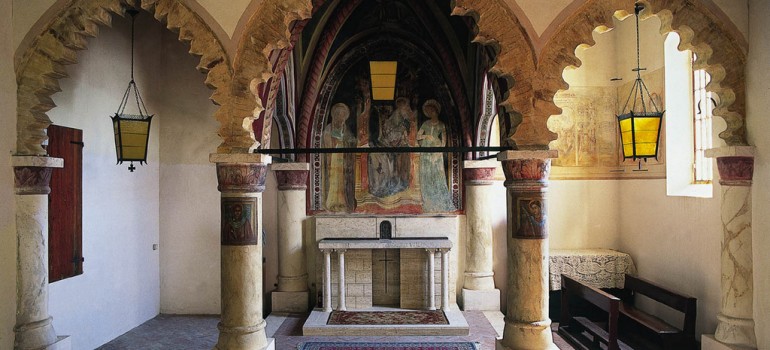
The Church of Santa Maria in Castello is a Romanesque church located in the medieval village of Marano, The first news about the Church is contained in a document written in 1227 is very likely, however, that its origins are older. The November 22, 1254 will be convened Parliament General Marano, composed of 137 family heads to ratify the pact signed the previous day with Fermo, aimed at the protection of the rights and duties of Maranesi. Tradition has it that, for a short time, before being transferred to the parish church, the body of St. Basso has been placed here. The martyr appears to have been shifted to Marano from Pieve in sec. X, when it is abandoned by the Benedictines. In 1330 and, later, at the end of the same century, the church suffers deep restorations. In 1614 its structure shows so dilapidated that the bishop shall order the reduction of the length. After the mid-nineteenth century the building became municipal property. In 1872 we returned the parish that remains until 1888. The church is facing a state of disrepair until the thirties, when it becomes private property together with the adjoining villa. The church, currently, is privately owned and is closed to worship. In 1946 begins a substantial restoration completed in 1948. The exterior facade, along the south wall on the highway, is minimally altered and the main entrance, decorated with an elegant portal semigotico. Under the eaves of the roof is largely reinstated the series of hanging arches to all sixth, and is built from scratch a small bell tower to support the bells. The interior of the church has three large poly-lobed arches supported by columns floors, the rooms have an Arab and Eastern explicable directly to the Saracen presence, living in the territory until the early years of the century. XIII. In the past, Santa Maria was called “Church of St. Philip” in memory of Blessed Antonio Grassi, Filipino father, ancestor of today’s family owners of the building and is depicted on a cloth placed over the side altar. The painting now occupies the space that was reserved in the fifteenth century to the painting Madonna and Child with Saints Sebastian and Basso by Vittore Crivelli, currently preserved in the church of Saints Basso and Margherita in Cupra Marittima.
Altri monumenti a Cupra Marittima
 Lascia un commento
Lascia un commento